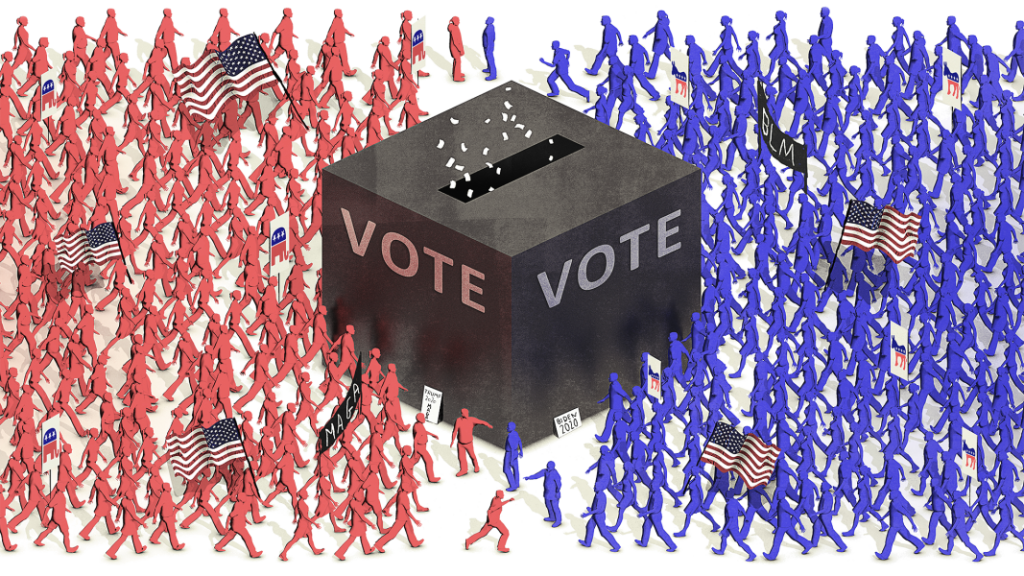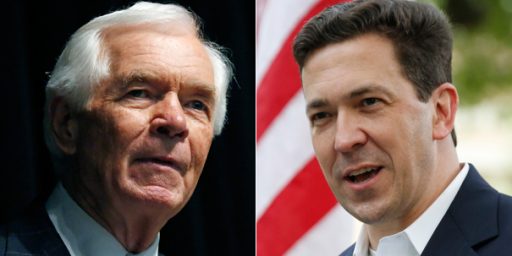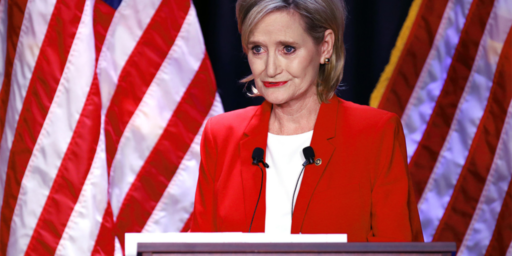Fixing the Primary Problem
Could Alaska point the way to a solution?

Veteran political analyst Ron Elving echoes a longstanding theme here at OTB in his NPR essay, “In a time of national division, polarizing primaries are part of the problem.”
The congressional hearings into the Jan. 6 attack on the Capitol are revealing how former President Donald Trump strove to stay in office by any means necessary.
They are also revealing the depth of division within our country.
A poll by Morning Consult this week found 84% of Democrats approving of the committee’s mission but just 20% of Republicans.
[…]
It is said the best medicine for what ails democracy is more democracy. But what does more democracy mean? If it just means more of the kind of politics we have now then it hardly offers a remedy.
Our current system produces a Congress and many state legislatures that have abysmal ratings from the voters and yet record high re-election rates for their individual members.
We need new mechanisms to reform, if not replace, the kinds of democratic processes we have. And efforts to find better processes are underway around the country, starting with the party primary system, which is a big reason the extremes tend to pull the parties further apart.
Primary voting is almost by definition dominated by activists, who tend to be more ideological. More moderate candidates who might represent the majority of citizens in a state or a district are at a disadvantage.
Again, this argument will not be new to regulars here. The backgrounder is helpful:
We have had primary elections to select nominees for general elections at the local, state and federal level for more than a century. They began as an alternative to having party bosses at each level simply name the candidates they wanted.
As the system has evolved, however, primaries have come to be dominated by ideological partisans who please the more agenda-driven elements in either party who are the most likely to participate in primaries.
There is comparatively little incentive to reach out to voters who might fall somewhere between the two parties. And that is especially true as computer-assisted gerrymandering creates more districts that are “safe” for one party or the other in November elections.
The usual retort here and elsewhere is that it’s the fault of those who sit on the sidelines and leave the culling process to the activists. But Elving makes a strong counterpoint:
That is increasingly problematic as fewer Americans identify with either major party. At the end of 2021, Gallup found 42% of Americans identified as independents – with 29% identifying as Democrats and 27% as Republicans. Roughly half the states that have registration by party now have more people registering as independents than as Democrats or Republicans. Gallup has also found the percentage of Americans favoring creation of a new major party has risen above 60% for the first time.
Regardless, the incentives are what they are:
Rather than respond to this by seeking common ground, the parties have continued to move further away from each other. Stanford political scientist Adam Bonica, among others, has charted this trend across the past four decades, demonstrating how the parties’ nominees for Congress have become more ideological and further apart. While the political center was inhabited by a substantial fraction of nominees in both parties in 1980, it is almost entirely deserted today.
And the outcome is what one would predict:
We should not think of this as simply a puzzle for professors. The growing gap affects our national life. In 2019, a Public Religion Research Institute study published in The Atlantic found Americans were more likely to object to their children marrying someone from the other political party than to someone from a different religion or race. Research by others has found much the same.
Fixing all of this is, to say the least, not easy:
One idea is to deemphasize party by having independent commissions draw the district lines rather than the legislators themselves. This has shown promise, although in some cases the commissions have become partisan or their work product has been rejected by elected officials who are partisans.
Another approach is to eliminate registration by party, allowing primary voters to choose nominees from the slate offered by either party. Taking this a step further, some states are allowing primary voters to choose among candidates from either major party or from another party or no party at all.
Now, I’m not a fan of this. To the extent political parties are useful as both a means of coordinating governing activity and signaling a governing agenda to voters, removing labels is problematic. And, while it would give voters more choices, more choices aren’t always good: it requires a lot more work to cull through them and, since most voters don’t follow politics that closely on a day in, day out basis, name recognition could become even more important than it is now.
This, though, is more appealing:
There may also be a ray of hope for lessened partisanship in the system known as ranked choice voting.
He explains what this is but anyone reading this far already knows. But how would it lessen polarization?
But the special election for Congress in Alaska this year offers an example of how it can work. The state’s longtime congressman, Don Young, died in March as he was beginning his 50th year in Congress.
Rather than holding the usual party primaries, Alaska is trying out a system its voters adopted by ballot measure in 2020. All candidates for Young’s seat appeared on one ballot this month (June 11) regardless of party affiliation. That made for a lot of reading, as no less than 48 Alaskans qualified for that ballot.
So, again, I’m not loving this. I’m a political junkie and even I wouldn’t take the time to read up on 48 candidates for a House seat. But here’s how RCV comes in:
Under the new system, the top four finishers in the June round of voting advance to a runoff on Aug. 16. And when they appear on that ballot the voters will not be asked just to choose one but to rank all four.
Best known of the four is the state’s former governor, Sarah Palin, who was also the vice-presidential nominee of the Republican Party in 2008. She resigned as governor in 2009 and has since been primarily a media figure on Fox News and elsewhere.
Palin, who was endorsed by Trump, topped the results in the June round with about 28%. Second at 19% was another Republican with name recognition, Nick Begich III, and two others made the cut with smaller shares.
Under the traditional primary system, Palin’s plurality would have put her in Congress. Or in a runoff with Begich.
Instead, Alaska’s ranked-choice runoff will give the voters a wider choice and a chance to effect an outcome closer to a general consensus.
Palin may be the first choice of more August voters than anyone, but as a controversial figure throughout her career she may also be the third or fourth choice for many. In the end, a better mix of first-choice and second-choice scores could elevate Begich or possibly one of the other two.
Palin’s showing in such a large field was impressive, in one sense. But more than 70% of those voters preferred someone else. By giving voters another chance to consider a winnowed field, the new system not only ensures a greater consensus but lets the voters themselves create that consensus.
So, even if you sit out the arduous process of culling 48 choices down to 4, you’re not reduced to a choice between the two extremist yahoos who got the most votes in the two party primaries. Nor is this like California’s “jungle primary,” which leaves only two choices, both of which are likely to be Democrats.
Instead, voters have four choices, at least one of whom will likely be reasonably acceptable to you. Further, someone will have to get a majority of support—either by getting 50% or more outright or by being the first or second choice once the least-favorite candidates are eliminated through the instant runoff.
I haven’t seen this sort of system play out enough to have a firm opinion. But I instinctively prefer it to the current model. It makes a lot of sense to elect representatives who are acceptable to a majority of voters rather than the candidate who won a plurality among the rabid partisans who bothered to show up in the primary.






Ranked Choice and Open Primaries (“jungle”) both reduce the power of extremists.
I, frankly, have no problem with both candidates in a general election being Democrats when the district is 90% Democrat to begin with. Why would we force a 50/50 vote between a candidate who represents 90% of the district against a candidate who represents 10%?
Ranked-choice accomplishes this as well, but its complexity is a turnoff for people who don’t follow politics, which makes it difficult to get approved. Once in place I imagine people like it quite well.
@Tony W:
A secondary advantage of using rank choice voting is that it can provide an opportunity for a third party to break through. And of course the winner would need to accrue 50%+1 of the vote, so no more first past the post.
I agree with you though, that an all Dem or all R final isn’t a problem if that reflects the preference of the voters and regardless it will have a moderating effect on who is finally elected to the office.
An even better enhancement would be multi-member districts for congressional and legislative races.
0
As an aside, why shouldn’t those actually bother to show up should have more of a say than those who don’t? The laziness of the American electorate is one of the most mystifying aspects of world politics. Makes no sense that a people who won’t participate also think we’re entitled to good government.
@DK: The majority of Americans simply aren’t rabid partisans, thinking neither party represents their interests. It’s not unreasonable that they, therefore, don’t vote in party primaries. And this is exacerbated by the fact that, at least if there’s not an incumbent from that party, having a plethora of candidates with the “winner” oftentimes someone who got something like 29% of the vote.
@DK:
Acknowledging the fact that the vast majority of independent voters have a party preference, but not a party affiliation, it becomes a problem when the not affiliated are half again the number of voters than identify with a party. Particularly if the party primary is open only to voters registered to that party.
But voting should be a requirement and not an option.
@James Joyner:
This is partly the result of Republicans who directly and deliberately make the case that both parties are the same and that your vote really doesn’t matter. When people are cynical and don’t vote, the status-quo becomes reality.
The best way to prevent change is to prevent change agents from taking office. Complacency is far more powerful than activism because it is much, much easier.
As someone living in a very R district & state, voting in the D primary is no different from voting in the Libertarian primary. So the choice is vote for the best D that will lose, vote for the least dispicable R, or skip it as a complete waste of time.
I admit that I have skipped it if it was going to cause me extra work.
Honestly, I think the best idea is probably for Ds to run as Rs and everyone vote R, but that requies way to much centralized control from the top down to the voters.
They’re either too lazy to spend the time figuring things out or they think they are sooo special they deserve a candidate who thinks just like they do and until they get one, they aren’t going to waste their precious vote by giving it to someone who agrees with them only 75% of the time. I’m not interested in giving either type a pass.
@Sleeping Dog: Aside from whether forcing people to vote violates their 1st Amendment rights, I don’t know how you could force them to vote in a party primary, let alone in one of the two major party primaries. And, frankly, in most House districts—and even most states—there’s de facto only one meaningful primary.
@Tony W: That both parties are the same is at least as big a belief on the left as it is on the right. Lots more Dems vote Green or other alternative parties than Republicans vote Libertarian.
@BugManDan: As I’ve noted here many times over the years, when I first started voting in the 1984 election, Alabama was a single-party (Democratic) state, at least for governor on down. That meant that, if you wanted to choose who the next governor/lt governor, attorney general, secretary of state, etc. would be you had to vote in the Democratic primary.
@James Joyner: You are talking about the voters who show up.
I am talking about complacency – the 1/3 or so of voters who can’t be bothered. Failure to vote is essentially a Republican vote – it is a vote for status-quo.
@Tony W:
Top Two and Top Four (CA and AK, respectively) make the promise that they will reduce the powers of the extreme. Top Two has not worked as promised, and we really have no data on Top Four.
All these things do is further weaken parties, which is part of how we got where we are. Also, given the nationalization of parties, what will happen with a slate of 48 candidates is not that voters will look for moderation, but that they will look for some combination of name recognition and national party cues. And if the national party cues are thins like the Big Lie, then…
I expect I will write more on this later.
@Tony W:
There are plenty of people who stay home who, if they voted, would also vote R. The notion that only D voters stay home is simply incorrect.
RCV in and of itself is not the fix it is stated to be. The only way RCV makes a real difference in our politics is if we go to RCV in multi-seat districts–that would lead, over time, to more party formation, especially if parties had control of their labels.
I would note that even if Top X with RCV in a single-seat distinct does, in fact, produce a candidate that appeals to the median voter in a given district the main variable for determining what that means is dictated not by the ideal moderate, but by what the views are of the medical voter in the district.
A core, perhaps the core, problem in our politics is that we have a system that represents citizens based on lines on the map rather than based on the interests that exist in the populace. Top Two, Top Four, or just straight-up RCV in a single-seat district does not fix that fundamental problem.
As quoted by the OP
This is both true and also does not make the point that Elving thinks he is making (and I have a lot of respect for Elving). Almost all of the of 42% are consistent R or D votes–they simply are not the distinct third category that we in the US keep insisting that they are in these conversations.
@Sleeping Dog: True, but Dr. Joyner’s objection seems specifically centered on the choices being Democrats, not both from the same party (which was a diction the language offers, very comfortably, I would add).
Have to admit to a daydream I had yesterday: All Democrats register as Republicans and take over the party. Easier than trying to push through the legislation and constitutional amendments to prevent minority rule and authoritarian tendencies.
@Steven L. Taylor:
Amen.
What data have you seen on the states that have applied some form of multi-member district? It seems to me a path to this kind of meaningful electoral reform would entail the promotion of the positive representative effects from MMD (even if those effects are modest) combined with state-level popular referenda calling to changes to state rules emerging from this promotion. Of course, I really would like to see a national referendum to redraw state lines as a corrective to our Electoral College problem, but I would also like a pony.
@Sleeping Dog:..But voting should be a requirement and not an option.
So you want the government to force citizens to cast a ballot in all elections or be punished.
Please post up drafts of the proposed Federal and State legislation that would bring about compulsory franchise. Be sure to include the sanctions that violators of these statutes will suffer.
@BugManDan:..I admit that I have skipped it if it was going to cause me extra work.
Better watch out for @Sleeping Dog. He might want to make you a test case.
@Steven L. Taylor:
I agree with this, as noted tangentially in the OP. It’s my objection to the Californa model. I think I prefer the Alaska “Top 4” model to what we have now but I’d likely more prefer simply going back to the party bosses selecting candidates.
@Steven L. Taylor:
That’s certainly a bigger fix. Alaska is an anomaly, in that it has a single Congressional District. I think the proposed system is better than the current model of two extremist nominees but there are likely bigger fixes that solve more problems.
@Just nutha ignint cracker:
No, it’s just that in California, the only place I’m aware of that uses this system, it’s always been two Democrats.
@Steven L. Taylor: Not discounting the effect of the map, I think another factor is that our system was probably designed to represent the interests of–and be run by–about 15 or 2o% of the population. And yeah, that’s true of most systems from probably before Plato. The difference with us is that while other nations have evolved–in some cases pretty substantially–the US path of evolution–to the extent that it exists at all–is more stunted–in some cases pretty substantially. And yes, I’ll go ahead and risk the wrath of MR and the gang and say the consequences of the stuff that makes the core of CRT plays a significant role in the problem. And the problems start at the close of the Civil War, where blacks were promised emancipation, citizenship, and the franchise but got sharecropping, southern terrorism and Jim Crow, and poll taxes and literacy tests.
“I’d likely more prefer simply going back to the party bosses selecting candidates.”
These are the thoughts of someone who’s more likely to be in social stratum the party bosses come from. I’d probably prefer a return to party bosses, too. Then again, I’m white, Protestant, middle class, a holder of equity in the market, and generally more corporatist when thinking about systems that will benefit ME. This is why I deliberately shy away from that line of thinking.
@James Joyner: I would expect that there are districts in CA, such as Devin Nunes’, that select two Republican candidates in the jungle primary.
Or Kevin McCarthy’s district. As best I can tell, McCarthy is not a radical so much as he is in the thrall of radicals.
@Just nutha ignint cracker: Shove in ranked choice voting, and the party bosses picking candidates would work well — don’t like their selection, form another party.
Seattle might have an initiative on the ballot to go with “approval” voting — not sure where they are with signatures. The idea would be that you can vote for every candidate that you could stomach, and the one with the most votes would win.
They just keep trying to figure out how to get people to accidentally elect goodspaceguy. Everyone will vote for the people they want and then think “oh, sure, I’ll toss a vote to goodspaceguy, he’s always on the ballot, he’ll never win…”
Australia has used RCV (called preferential voting there) for a century. My observation, as an Aussie who has lived in the US for nearly 20 years, is that Aussie politics is far more centrist than US politics. I should add though that they have independent commissions draw electoral boundaries, and compulsory voting, so “motivating the base” is not a thing, so that probably helps too. But even in the few really safe seats, extreme candidates are a liability because they damage the overall party brand and lead to losses in other more competitive races. We saw this in the recent Federal election loss by the conservatives.
When I was in high school, our civics teacher (whose uncle was major albeit strictly local cog in the GOP machine) said that an advantage of the primary system was that it forced a serious candidate for president to show that they could pull together a national organization and large group of supporters. Candidates that were perceived as regional would have to reach out beyond their comfort zone (not her phrase, of course) and make connections with other regions.
It made sense back then, but things have changed dramatically since then. A strong media presence can compensate for lack of organization structure (see just about any presidential campaign run by Newt Gingrich since 2004). And now with social media, there are no restraints at all.
@Just nutha ignint cracker: It’s not like the primary system is giving us a lot of working class candidates. The party bosses would pick people they thought would appeal to a majority of voters in November. A first-past-the-post primary tends to give us extremist candidates.
@Just nutha ignint cracker:
I can’t speak for James, but I will say that I have come to the conclusion that elite selection of candidates is almost certainly superior because it actually creates a context in which more competition occurs. This is because new factions that emerge in national politics would have to form new parties instead of playing primary games. This would increase transparency in our politics and also make it harder for extremists to capture full control of major parties in stealthy ways.
I would note that no other democracy on planet Earth uses the kind of nomination processes we do. Not one.
Very late to this but an interesting comparison:
The general system in Europe (note that nations may vary): there usually are no such things as “primaries”.
Party candidates are chosen by the parties.
They may, or may not, have their members vote for candidates; or they may be appointed by a local board, or by the central party executive, or by a party congress.
But it is a private, not a public, matter (they could still choose to have an open election, I suppose, as a private decision; but it’s very rare).
Party leaders are usually elected internally, but it’s still a matter of choice, not a legal requirement.
Essentially, parties are corporate bodies, controlled by their members; who generally have to pay membership fees.
There is no such thing as publicly declared party affiliation for non-members.
One bonus: it enables a party central authority to discipline its membership.
It can boot out extremists (or, for an extreme party, boot out non-extremists, LOL) more or less at will.
As I say, its just a comparison.
Political systems and societies are very different; and there’s always the “Drive to London? I wouldn’t start from here, if I were you” (AKA path dependency) issue
But the though occurs that in an overly politically polarised society, and where parties are liable to “enthusiast base capture”, the best solution may not be more politics, more democracy.